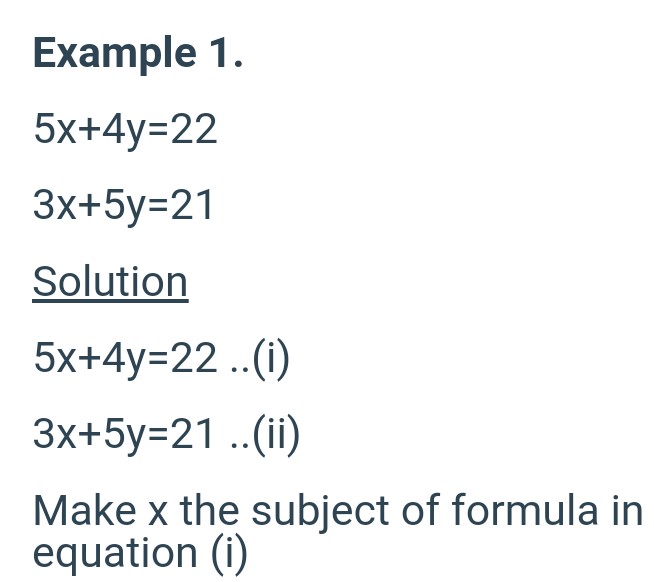
At the end of this article, you shall know how to solve any given problems of simultaneous equation with examples by methods.
It will be understood that if we have two unknown quantities whose values are to be determined, it must be possible to make an expression of them on two equations where the two unknowns could be connected.
Therefore, whenever there exist two unknown quantities whose values are to be determined in two equations at the same time, such equations are tearmed simultaneous equation.
Examples/Problems Of Simultaneous Equation
The following is an example of simultaneous equation:
3x+2y=10 ….(i)
x+2y=2 ….(ii).
Note: Quadratic equation looks similar to simultaneous equation.
If you haven’t read how to solve quadratic equation, you may click here to read and study it now before we move ahead.
In this article, I will teach you how to solve simultaneous equation problems with examples by methods.
Methods For Solving Any Problems Of Simultaneous Equation
Currently, there are two main methods of solving simultaneous equation and they are the following:
- Substitution method and
- Ellimination method
Above are the two methods which you can use to solve simultaneous equation easily.
Tip: It is more convenient and easier to use substitution method for simultaneous equation where one of the coefficient of the unknowns is 1.
Solutions Of Simultaneous Equation By Substitution Method
Simultaneous equation can be solved by using the substitution method because, it is a simple one.
When using the substitution method to solve simultaneous equation, one of the unknowns is made the subject of the formula in one equation. This is later substituted for in the second equation to have a simple equation in one unknown. Then the equation is solved linearly to obtain one value and the one value obtained is therefore substituted for to derive the other unknown.
Let’s use the following examples for further explanations:
Example 1.
5x+4y=22
3x+5y=21
Solution
5x+4y=22 ..(i)
3x+5y=21 ..(ii)
Make x the subject of formula in equation (i)
5x+4y=22
5x=22-4y
x=22-4y/5
Let’s substitute for x in equation (ii)
3x+5y=21
3(22-4y)/5+5y=21
66-12y/5+25y=125
330-12y+125y=625
113y=295
y=2.6, =3 (approximately)
To find x, substitute for y in any of the original equations, say equation (i)
5x+4y=22
5x+4(3)=22
5x+12=22
5x=22-12
5x=10
x=10/5
x=2
Answer: y=3 and x=2.
7 best Universities in Nigeria that will admit candidates with low jamb score for 2020
Solution Of Simultaneous Equation By Elimination Method
By using elimination method to solve simultaneous equation, one of the two unknowns is made to be removed either performing addition or subtraction on the two equations.
It must be noted that any unknown that is to be eliminated must have equal coefficient in order to facilitate addition or subtraction that is to be performed.
The following examples are used for further explanations:
Example 1.
2x+4y=42
6x-4y=30
Tip: If the two equations given have the same signs (i.e ++), then subtract and if the equations both have different signs (i.e +-), then add.
Solution
2x+4y=42 …(i)
6x-4y=30 …(ii)
2x-(+)6x=42-(+)30
-4x=12
x=12/-4
x=-3
To solve y, substitute for x in. equation (i)
2x+4y=42
2(-3)+4y=42
-6+4y=42
4y=42+6
y=48/4
y=12
Example 2
3m-5n=11
4m-6n=16
Examlle 2
3m-5n=11
4m-6n=16
By observation, you can discover that either by addition or subtraction of the two equations, none of 69FGB the unknowns will be eliminated. The reason for this is simple and it is that none of the two unknowns has equal coefficients in either of the two equations.
To solve our number two question, we now choose any unknown which we want to eliminate. After making this choice, the coefficient of such choice if unknowns are then interchanged to multiply each if the two equations.
Let’s solve.
3m-5n=11 …(i)
4m-6n=16 …(ii)
Let us choose m as the choice of unknown to be eliminated, thus multiply equation (i) by 4 and equation (ii) by 3.
12m-20n=44 …(iii)
12m-18n=48 …(iv)
Therefore, 12m-12m-20n+18n=44-48
-2n=-4
n=2
To find m, substitute for n kn equation (iv)
12m-18n=48
12m-18(2)=48
12m-36=48
12m=48+36
m=84/12
m=7
Example 3
5a-2b=19
3b-4a=-18
Solution
5a-2b=19
3b-4a=-18
5a-2b=19 …(i)
4a+3b=18 …(ii)
Let’s eliminate b
15a+6b=57 …(iii)
8a+6b=36 …(iv)
7a=21
a=21/7
a=3
Substitute for the value of a (3) in equation (ii) above
4a+3b=18
4(3)+3b=18
12+3b=18
3b=18-12
3b=6
b=6/3
b=2
If you like this article, then give it a thumbs up and don’t forget to share it with your friends.
If you’ve found this article helpful, please follow us on Facebook or Twitter.




